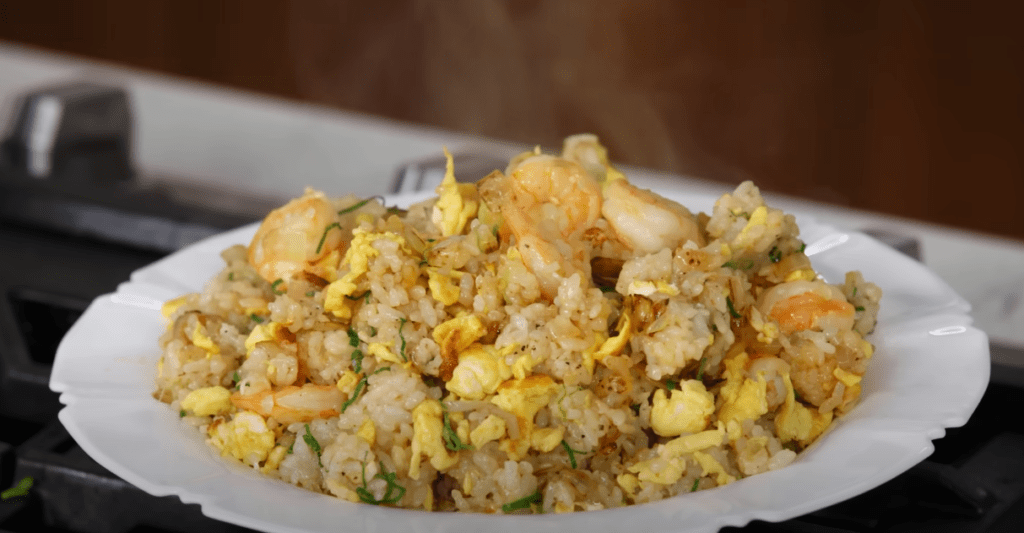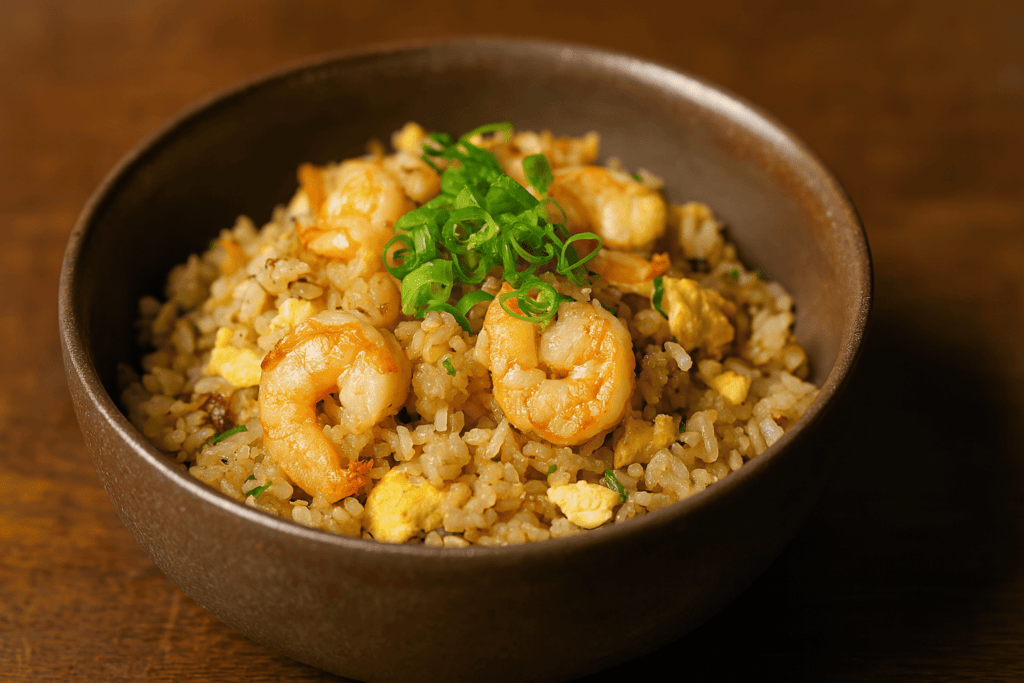Is pork fried rice healthy? Pork fried rice can be an integral part of a balanced diet—if prepared thoughtfully. From the approach outlined here, the key factors that make fried rice more wholesome are:
- Careful protein selection and cooking:
In this recipe, shrimp was used as a lean protein source. If you substitute pork, choose lean cuts like tenderloin or trimmed loin chops instead of fatty cuts or processed pork. Sear them separately in a hot wok (just like the shrimp) so you can control doneness without excess oil or overcooking.
In this recipe, shrimp was highlighted as a lean protein, low in saturated fat and quick to cook. If you prefer pork, it’s important to:
- Choose lean cuts, such as pork tenderloin, pork loin chops trimmed of visible fat, or center-cut pork chops. These cuts are significantly lower in fat compared to pork belly, shoulder, or processed pork (like sausages or bacon).
- Cut the pork into small, even pieces, so it cooks quickly and evenly without drying out.
- Sear the pork separately in a very hot wok until lightly browned on the outside and cooked just to doneness. This prevents overcooking and keeps the texture tender.
- Avoid crowding the pan so the pork sears instead of steaming (steaming makes it rubbery and watery).
Why it matters:
- Lean pork is an excellent source of complete protein, zinc, and B vitamins.
- Searing quickly over high heat locks in moisture without requiring excess oil.
Table of Contents
Toggle🔥 2️⃣ High-Heat Stir-Frying
This is a cornerstone of healthy fried rice:
- Preheat the wok until it is nearly smoking before adding oil or any ingredients.
- High heat creates a Maillard reaction (that delicious browning), which develops flavor and slight crispiness.
- When the rice hits the hot wok, moisture immediately evaporates instead of soaking the rice, preventing sogginess.
- Because everything cooks quickly, you use less oil overall.
Why it matters:
- Reduces the need to add more oil or sauce to compensate for bland or wet rice.
- Retains vibrant colors and nutrients in vegetables.
🫒 3️⃣ Use of Neutral Oil Sparingly
Instead of saturating the wok with oil:
- Use just enough neutral oil (like canola or grapeseed) to lightly coat the cooking surface.
- Swirl or brush the oil around the sides of the wok to prevent sticking.
- Reapply a small drizzle only when you add new batches of ingredients.
Why it matters:
- Keeps fat content reasonable.
- Allows the natural flavors of pork, egg, and aromatics to shine without being greasy.
🥬 4️⃣ Avoiding Watery Vegetables
- Many people overload fried rice with high-moisture vegetables like zucchini, mushrooms, or tomatoes. While healthy, they release water when heated:
- Excess moisture steams the rice instead of frying it, leading to a mushy texture.
- Steam lowers the wok temperature, forcing you to cook longer and possibly add more oil to prevent sticking.
Instead:
- Choose vegetables like carrots, peas, bell peppers, or snap peas.
- Pat them dry before cooking.
- Add them quickly over high heat to retain crunch.
Why it matters:
- Maintains the crisp, separated texture of the rice.
- Reduces the likelihood of greasy or soggy results.
⚖️ 5️⃣ Balanced Portions
Fried rice is naturally calorie-dense because:
- It includes starchy rice, protein, fat from oil, and sometimes rich sauces.
- Even a home-cooked portion can reach 450–500 kcal per serving.
To keep it balanced:
- Stick to a moderate serving (about 1–1½ cups cooked) per meal.
- Serve with a side of lightly dressed salad or steamed greens.
- Avoid making it your only dish if you’re concerned about calories.
Why it matters:
- Prevents overconsumption.
- Ensures you get a variety of nutrients on your plate.
🧂 6️⃣ Nutritional Considerations
Saturated Fat:
- Pork, even lean cuts, contains slightly more saturated fat than shrimp.
- This isn’t inherently bad—but if you’re watching your cholesterol, balance your intake across meals.
Sodium:
- Soy sauce is high in sodium.
- In this recipe, soy sauce is used mainly for aroma, with most saltiness coming from simple salt.
- If needed, you can:
- Use low-sodium soy sauce or tamari.
- Reduce the amount of soy sauce to a drizzle for flavor only.
- Skip extra salt if you’re sensitive to sodium.
Why it matters:
- Moderating sodium helps maintain healthy blood pressure.
- Controlling saturated fat keeps the dish in line with most heart-healthy eating guidelines.

In summary:
Homemade pork fried rice can be a healthy, satisfying meal when you use lean pork, minimal oil, and control the portion size—just as you would with this shrimp and egg fried rice. It’s much healthier than most takeout versions, which are often cooked with more oil, fatty cuts, and added sugars.
📺 Best YouTube Video
▶️ Watch the full recipe video here (sample link)
